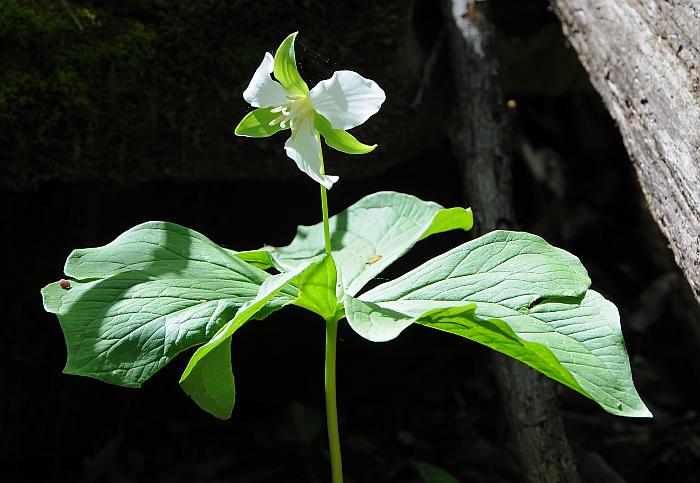Trillium flexipes Raf.
White Trillium

Native
CC = 8
CW = 0
MOC = 14
© SRTurner
Trillium flexipes Raf.White Trillium | |
 |
Native CC = 8 CW = 0 MOC = 14 |
© SRTurner |
|
Family - Liliaceae Habit - Rhizomatous perennial forb.
Stem - Aerial stem erect, 20-40 cm long, unbranched, glabrous. Leaves - In a single whorl of 3 (4 or 5 in aberrant plants) at the tip of the aerial stem, 7-20 cm long, about as long as wide, rhombic, strongly acuminate at the tip, sessile, usually not mottled, the upper surface lacking stomates or with only a few near the tip.
Inflorescence - Solitary terminal flower, spreading horizontally to nodding below the leaves, with stalks 3-12 cm long. Flower - Perianth with the petals and sepals free. Sepals herbaceous and green, spreading to ascending, 20-50 mm long, lanceolate, not purplish tinged. Petals 20-50 mm long, narrowly ovate, white. Stamens 6, free, erect, 8-20 mm long, less than half as long as the petals. Styles 3, the bases erect and sometimes fused, the upper portions elongate, spreading, the stigmatic areas along the inner sides. Ovary superior, sharply 6-angled, with 3 locules, each with 4-10 ovules, 3- or 6-angled, ribbed or winged.
Fruits - Berries, 8-25 mm long, nodding below the leaves, ovoid to ellipsoid, the tips beaked with the persistent styles.
Flowering - April - May. Habitat - Rich bottomland forests, lower slopes of valleys and ravines. Origin - Native to the U.S. Lookalikes - Broadly, T. nivale, T. pusillum. Other info. - This species is found in a few counties on the eastern side of Missouri. Its range from there extends mainly to the north and east, throughout the upper American Midwest and also into Canada. It is a widely recognized flagship species for relatively undisturbed bottomland forests. It is not particularly common in Missouri, but in areas north can sometimes form large colonies along roadsides. The Trillium genus is easily recognized by its solitary stems bearing a single whorl of 3 large leaves each. Unlike the more common wake robins, this species bears its white-petaled flower at the end of a long stalk, which arises from the center of the leaf whorl. This is the largest species of Trillium in Missouri. Photographs taken at Earthquake Hollow Conservation Area, Callaway County, MO., 4-22-04 (DETenaglia); also at Weldon Spring Conservation Area, St. Charles County, MO, 04-18-2010 and 04-22-2016, and at Engelmann Woods Natural Area, Franklin County, MO, 04-29-2019, 8-6-2021, and 4-28-2025 (SRTurner). |